Gasparilla Pirate Festival
| Gasparilla | |
|---|---|
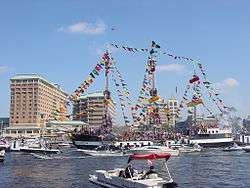 The Jose Gasparilla sails into downtown Tampa during the Gasparilla Pirate Festival | |
| Official name | Gasparilla Pirate Festival |
| Observed by | Residents of Tampa, Florida and the Tampa Bay area |
| Observances | 103 |
| Begins | late January (Children's Parade) |
| Ends | early March (Outward Voyage Home) |
| 2017 date | January 28 |
| 2018 date | January 27 |
| 2019 date | January 26 |
| Frequency | annual |
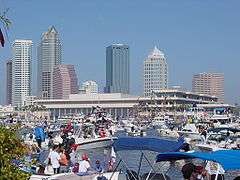
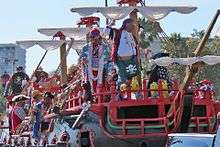
.jpg)
The Gasparilla Pirate Festival is a large parade and a host of related community events held almost every year since 1904 in Tampa, Florida celebrating the apocryphal legend of José Gaspar (also known as Gasparilla), a mythical Spanish pirate who supposedly operated in Southwest Florida in the early 1800s.
Tampa's Gasparilla season runs from mid-January to early March and features three large parades. The focal point of Gasparilla is the Parade of Pirates, which features a friendly invasion by Ye Mystic Krewe of Gasparilla and a large parade along Bayshore Boulevard into downtown. The Parade of Pirates (which is often referred to as the Gasparilla Parade by locals) is held on the last Saturday in January. It is the third largest parade in the United States with an economic impact of over $20 million and an average attendance of about 300,000.[1] Other major parades during the season are the Gasparilla Children's Parade, which is held on Bayshore Boulevard one week before the main parade, and the Sant'Yago Illuminated Knight Parade, which is organized by the Krewe of the Knights of Sant'Yago in the historic neighborhood of Ybor City two weeks after the main parade.
Tampa hosts many other Gasparilla-related or monikered events during its Gasparilla season, including the Gasparilla Film Festival, the Gasparilla Festival of the Arts, the Gasparilla Distance Classic, and the Gasparilla Music Festival, with a changing lineup of smaller events held year to year. The Gasparilla Parade of Pirates once coincided with the Florida State Fair, which was held at Plant Field at the end of the traditional parade route in downtown Tampa. The close connection between the fair and Gasparilla ended in the mid-1970s, when the fair moved to a much larger location east of Tampa.
Description
Parades and pirates
Gasparilla Parade of Pirates
The theme and focal point of Gasparilla is a friendly "invasion" by mythical pirate José Gaspar and his crew. On the day of the Gasparilla Parade of Pirates, members of Ye Mystic Krewe of Gasparilla (YMKG), accompanied by a flotilla of hundreds of smaller private boats, sail across Tampa Bay to downtown Tampa on the Jose Gasparilla, a 165' long "pirate" ship which was specially built for this purpose in 1954.[2] The ship moors beside the Tampa Convention Center with much firing of cannons, after which the "pirate captain" and his crew disembark to demand that the mayor hand over the key to the city in a playful ceremony which has had different outcomes in different years.[3] Whether or not the mayor actually "surrenders", the pirates hold their "victory parade" through the streets of Tampa, with much of the route running along Bayshore Boulevard.
During the parade, members of Ye Mystic Krewe of Gasparilla and dozens of other krewes throw beads, coins, and various souvenirs to the throngs from mostly pirate-themed floats. Area high schools and universities provide marching bands, majorettes, and drill teams, and many local businesses and organizations participate by entering elaborate floats and joining the krewes in throwing beads and other trinkets to the crowd. In the past, members of YMKG would also fire .38 six-shooters loaded with blanks into the air and toss the empty shells into the crowd. This tradition was restricted in 1992 and ended entirely several years later.[4] However, trained members of YMKG still fire loud mini-cannons mounted atop several of their parade floats. The main parade is broadcast every year on WFLA-TV, and has been since 1955; station WTVT-TV also covered the parade from 1955 to 1980.
Several semi-theatrical events around the "invasion" have become traditional:
- Beginning in 1956, a small US Navy ship would volunteer to be "attacked" by small boats of the "Ybor City Navy" armed with stale Cuban bread and water hoses. The US Navy returned "fire" with their own water hoses but would eventually surrender to the Alcalde of Ybor City, who had, as the story goes, been hired by Jose Gaspar to clear resistance to his impending pirate attack. After the "battle", the navy sailors would be treated to an evening on the town. This event was temporarily discontinued after the September 11, 2001 attacks, but has been held sporadically since, with the museum ship SS American Victory usually standing in for the US Navy.[5]
- The Outward Voyage Home is the culminating event of the Gasparilla season which was revived in 2008 after being discontinued in 1964. During this ceremony, the Ye Mystic Krewe of Gasparilla's pirates return the key of the city to the mayor, then climb aboard the Jose Gasparilla and "sail away" across Tampa Bay while festivities continue along the Tampa Riverwalk. The Outward Voyage usually takes place on the first Saturday in March.[6][7]
Children's Parade
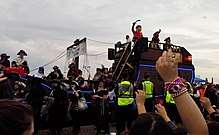
The Children’s Gasparilla Extravaganza is usually held on the Saturday prior to the main parade. The parade route also runs along Bayshore Boulevard, but it is shorter than the main Gasparilla parade. It is billed as a "family friendly" event, as unlike during the Parade of Pirates, alcohol is not allowed along the parade route.[8] The Children's Parade was first held in 1947 and has grown over the years, and now includes a similar mix of Krewes and floats built by local businesses and organizations. It also features participants from various youth organizations, and the children of Krewe members often ride along on the floats tossing beads. Various related activities and events for children are held in downtown Tampa in the hours before the Children's Parade.[9]
Sant'Yago Knight Parade
.jpg)
The Sant'Yago Illuminated Knight Parade (sometimes referred to as the "Gasparilla Night Parade") has been organized since 1972 by the Krewe of the Knights of Sant'Yago. It is held in the historical neighborhood of Ybor City on a Saturday night, usually two weeks after the Parade of Pirates in mid-February.[10] The Knight Parade features a similar mix of participants as the Parade of Pirates, though most of the floats are brightly illuminated since the event begins after dark. Though it once had a reputation of being the most "adult-oriented" parade of Tampa's Gasparilla season, organizers have tried to reduce drunkenness and unruly behavior in recent years and have promoted it as a family-friendly event, with some success.[11][12]
Additional events of "Gasparilla Season"
Besides the Gasparilla Children's Parade (first held in 1947), the Sant'Yago Knight Parade (first held in 1972), and the many galas, parties, and fundraisers hosted by individual krewes, Tampa has long hosted a variety of other Gasparilla-related events from approximately January through March. One of the first was the Gasparilla Open, a PGA Tour stop which was sponsored by Ye Mystic Krewe of Gasparilla from 1932 to 1935. The 1935 edition had the largest prize purse on that year's PGA Tour ($4000), but with the deepening of the Great Depression, the tournament was discontinued thereafter. It returned in 1956 as the Gasparilla Invitational Tournament, an amateur competition which has been held annually ever since.[13]
Other large-scale events held during the Gasparilla season include the Gasparilla Festival of the Arts (established 1970), the Gasparilla Distance Classic (established 1978), the Gasparilla Film Festival (established 2006), and the Gasparilla Music Festival (established 2013).[14] A changing lineup of smaller events held in Tampa during the first months of the year also use the Gasparilla name.[15]
Many of the activities, organizations, events, and businesses that make use of the names "Gasparilla" or "Gaspar" are not affiliated with Ye Mystic Krewe of Gasparilla or the City of Tampa, as these names are not legally controlled by any organization. While some feel that this "co-branding" helps to promote all Gasparilla-monikered events and the Tampa area as a whole, others feel that overuse of the name will "water down what it means", and that the potential failures or missteps of one event or organization could reflect poorly on all the others.[16]
Economic impact
The average crowd at the main parade is over 300,000 people, with over 1,000,000 attending at least one Gasparilla event. According to several studies, the Parade of Pirates has a local economic impact of over $22 million, and the combined events bring in over $40 million.[16][17] The parade is the third largest parade in the US. Beginning in 2015, Visit Tampa Bay, the local tourist bureau, began a multimillion-dollar promotional campaign in the northern United States, Canada, and Europe to attract more visitors to Tampa during its "Gasparilla Season".[15]
History

Inspiration
The theme of the Gasparilla Festival was inspired by the local legend of José Gaspar, a Spanish naval officer who turned to piracy. Different legends say that he was either a nobleman and adviser to King Charles III of Spain who was exiled after a romantic scandal in the Spanish court or an ambitious young officer in the Spanish navy who was driven to mutiny by a tyrannically cruel captain. Whatever his reasons, the stories agree that Gaspar stole away in the late 1700s to the virtually uninhabited southwestern coast of Spanish Florida and established a secret base on Gasparilla Island in Charlotte Harbor. Gaspar is said to have plundered many ships and taken many female hostages in almost four decades of roaming from Louisiana to the Spanish main aboard his stolen flagship, the Floridablanca. His exploits came to a sudden end in 1821 when, to avoid being captured by the schooner USS Enterprise, he wrapped himself in the ship's anchor chains and threw himself overboard while shouting ""Gasparilla dies by his own hand, not the enemy's!"[18]
Despite this colorful history, there is no evidence that a pirate named "Gaspar" or "Gasparilla" ever operated off the Florida coast. Archives in Spain make no mention of Gaspar as a member of the Spanish court or an officer in the Spanish navy. The United States Navy has no record of any interaction with the mythical buccaneer or a person claiming to be member of his crew, and the name Gaspar does not appear in the official court records of piracy trials from the era in which he supposedly operated. In fact, researchers in Spain and the United States have not uncovered any archival evidence that Gaspar actually existed, and no physical evidence of his sunken ship or "regal" base has ever been found in Florida.[19][18]
The first written account of José Gaspar was in a 1900 advertising brochure for the Charlotte Harbor and Northern Railroad Company, a part of Henry B. Plant's railroad system that ran to Plant's Boca Grande Hotel in Charlotte Harbor. The brochure greatly embellished tall tales attributed to the late John Gomez, a well-known local fisherman and guide, to create the story of the pirate Gaspar, "The Last of the Buccaneers". It also mentioned that neither Gaspar nor his crew had ever retrieved his vast treasure cache, which was supposedly still hidden somewhere on Gasparilla Island, which was of course the location of the Boca Grande Hotel.[18][19][20] Subsequent tales of the pirate Gaspar are based on that fanciful brochure, including several erroneous mentions in books about Florida history or piracy in the Caribbean.[19]
Pirate festival
Origins
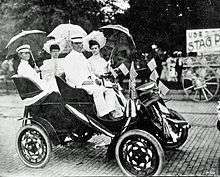
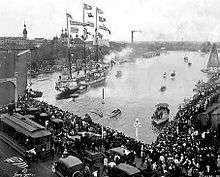
The first Gasparilla parade was held in May 1904, after Tampa Tribune society editor Louise Frances Dodge and Tampa's director of customs George Hardee combined the legend of the dashing pirate with elements of a New Orleans Mardi Gras / Carnivale festival to give Tampa's relatively sedate May Day celebration a new theme with local connections. The first Gasparilla "invasion" was on horseback, with the first sea-based invasion coming in 1911.[2][20][21]
Parade of Pirates
The Gasparilla parade was usually held in conjunction with various other local events before World War I, so its date varied and it sometimes was not held at all. When it resumed in 1920 after a war-time hiatus, it became a stand-alone event held in February. This schedule coincided with the Florida State Fair, which was held beginning in 1924 at Plant Field near downtown Tampa. The events merged, and for half a century, the parade route ended at the fair grounds, drawing many thousands of spectators to the combined festivities. The Florida State Fair moved to more spacious quarters east of Tampa in 1976, which is the same year that the Lee Roy Selmon Expressway was built near the mouth of the Hillsborough River, preventing the Jose Gasparilla from sailing upriver as it had for decades. Since the mid-1970s, the pirate ship has docked on the south side of downtown Tampa on Gasparilla Day, and the Parade of Pirates route has usually run from a starting point near the south end of Bayshore Boulevard back to downtown, approximately four miles in total.[22]
The Gasparilla parade was held on the second Monday in February in the decades following another hiatus during World War II. It was an official holiday in Tampa, with local schools and government offices closed for the day along with some businesses. In 1988, the Parade of Pirates was moved to the first Saturday in February to make it easier for residents of other communities to take part in the festivities. Since 2005, the event has been held on the last Saturday of January.[22]
Krewes and controversy
Much of the festivities during Tampa's Gasparilla season (including the thee parades and other events before and after), are organized by "krewes", which are private clubs of local citizens organized into social and charitable organizations inspired by the krewes of New Orleans. Tampa's Krewes hold social events and parties throughout the year, often to raise money for favored charities and causes. Krewes tend to be most active during the Gasparilla season, with social events beginning as early as the latter part of December.[22]
"Ye Mystic Krewe of Gasparilla" (YMKG) was Tampa's first krewe, and its members have organized the Parade of Pirates since the first Gasparilla festival in 1904. YMKG's membership includes civic leaders and businessmen from Tampa, which for many decades meant that the organization was exclusively white and male, causing growing resentment among local African-Americans and other groups.[23] The Krewe of Venus (which is a female-only krewe consisting mainly of the relations of YMKG members) joined the festivities in 1966, and the Krewe of Sant'Yago (which was formed by leaders of Tampa's Latin community centered in Ybor City) formed in 1972, but much of Tampa's diverse population was left out, and some observers questioned the image of the local elite dressing as pirates and pretending to plunder the city.[24][18]
The issue grew into a heated controversy in 1990, when the Krewe and the city planned to move Gasparilla up a few weeks to coincide with Super Bowl XXV, to be played at Tampa Stadium in January 1991.[25] The city and the National Football League put pressure on the Krewe of Gasparilla to admit African-American members before the next event, but the organization refused and cancelled Gasparilla instead[26]
The city of Tampa hastily put together a replacement parade called "Bamboleo", which was billed as a "multicultural festival" and did not include pirates. A rainy day helped to dampen the crowds, and the replacement was considered a "flop".[25] Later in 1991, the Krewe of Gasparilla agreed to accept black members and allow more krewes to participate in the parade, and Gasparilla returned for 1992[27]
In 2001, Tampa again hosted a Super Bowl (Super Bowl XXXV), and the city again moved the parade to coincide with the game. On that occasion, there was no controversy, as an integrated Krewe of Gasparilla was joined by over 30 other diverse krewes for the parade, which drew a record crowd estimated at 750,000.[25][28]
The number of new krewes has continued to grow in recent years. Many of these krewes are organized around various ethnic, cultural, and historical themes or favorite charity causes. Members often spend a great deal of money on elaborate costumes, beads, and floats, much like the krewes of Mardi Gras. Currently, over 50 krewes march in each parade, with smaller krewes participating on a rotating basis due to the limited number of available slots. Many of the same Krewes - large and small - also participate in the Gasparilla Children's Parade and the Sant'Yago Knight Parade.[21]
References
- ↑ "Gasparilla parade's 100th edition marked by mostly behaved revelry". Tampa Bay Times. January 31, 2015. Retrieved 6 October 2015.
- 1 2 The History of Gasparilla Pirate Fest - Tampa, Florida Archived 2012-06-07 at the Wayback Machine.
- ↑ Vander Velde, Jessica (January 24, 2012). "Tampa Mayor Buckhorn defies Gasparilla pirates, keeps key to city". Tampa Bay Times. Retrieved 6 October 2015.
- ↑ AP (14 January 1992). "Gasparilla Pirates Try to Shed Old Image". The Lakeland Ledger. Retrieved 22 January 2014.
- ↑ Gasparilla Pirate Fest - Tampa, Florida
- ↑ Gasparilla Farewell
- ↑ Kennedy Wynne, Sharon (21 January 2018). "2018 Children's Gasparilla Parade: Guide and insider tips". tbo.com. Retrieved 21 January 2018.
- ↑ Kennedy Wynne, Sharon (18 January 2018). "2018 Children's Gasparilla Parade: Guide and insider tips". Tampa Bay Times. Retrieved 27 January 2018.
- ↑ The Krewe of the Knights of Sant'Yago historical marker
- ↑ The Krewe of the Knights of Sant'Yago official website
- ↑ Shopes, Rich (15 Feb 2015). "Annual Knight Parade lights up Ybor with family-friendly revelry". tampabay.com. Tampa Bay Times. Retrieved 21 January 2018.
- ↑ Korun, Tom (February 24, 2011). "Palma Ceia Country Club hosts long-time event rich in tradition". ABC Action News, Tampa. Archived from the original on 7 October 2015. Retrieved 6 October 2015.
- ↑ "Gasparilla season events". Visit Tampa Bay. Retrieved 22 September 2015.
- 1 2 Griffin, Justine (15 January 2016). "Tourism boosters hope Gasparilla 'season' lures more travelers to Tampa Bay". Tampa Bay Times. Retrieved 24 January 2016.
- 1 2 "Tampa's Old Guard Wary of Diluting Gasparilla". Tampa Bay Business Journal. January 30, 2015. Retrieved 6 October 2015.
- ↑ "Business Hunt for Gasparilla Booty" - St. Pete Times
- 1 2 3 4 dAns, André-Marcel (1980). "The Legend of Gasparilla: Myth and History on Florida's West Coast". Tampa Bay History. Tampa, Florida (Fall/Winter 1980). Retrieved May 20, 2012.
- 1 2 3 Bickel, Karl A. (1942). The Mangrove Coast. Coward McCann, Inc.
- 1 2 1999 Gasparilla Pirate Fest Archived 2012-02-21 at the Wayback Machine.
- 1 2 Seed for Gasparilla was planted in the Tribune's old newsroom | TBO.com
- 1 2 3 Scherzer, Amy (31 January 2015). "Travel through time with our '100 doubloons' of Gasparilla in Tampa Bay". Tampa Bay Times. Retrieved 27 January 2018.
- ↑ Citytimes: Gasparilla: a sober talk
- ↑ Wexler, Kathryn (1 Feb 2002). "New Krewes, Old Questions". St. Petersburg Times. Retrieved 27 January 2018.
- 1 2 3 A diverse Gasparilla appeases its critics
- ↑ Stevenson, Jennifer L. (May 30, 1991). "Krewe accepts 2 black members". St. Petersburg Times.
- ↑ "Pirates back for Gasparilla invasion" - The Lakeland Ledger, Feb. 1, 1992
- ↑ Superbowl2001: Gasparilla Supersized
External links
- Gasparilla Pirate Festival - Official Site
- Ye Mystic Krewe of Gasparilla Records at the University of South Florida